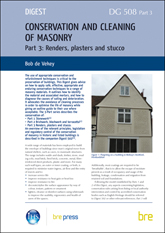
Conservation and cleaning of masonry - Part 3: Renders, plasters and stucco Downloadable Version
The use of appropriate conservation and refurbishment techniques is critical to the preservation of buildings. This major Digest gives advice on how to apply safe, effective, appropriate and enduring conservation techniques to renders, plasters and stucco. It outlines how to identify plaster and render constituents and associated mortars, and how to diagnose the causes of deterioration. It advocates avoidance of cleaning to optimise the life of masonry but outlines its use where appropriate. The first part of the Digest (published in 2008) dealt with conservation of stonework, and the second part (published in 2009) covered brickwork, blockwork and terracotta. The companion Digest 502 explains the principles of the conservation of masonry in historic buildings.
Illustrations
4 line drawings, 18 photos
Pages
24pp
Contents
Terminology
History of the use of internal and external plaster
-Lime and cement-based materials
Binder development
-Gypsum-based plasters used largely for internal finishes
Identifying and reporting plaster and render constituents, their specification and condition
-Determining and reporting of condition
Constitution, sources of raw materials, manufacturing, varieties and how plasters and renders work
-Gypsum plaster wall coatings and polymer-bound fillers
-Mortar-based wall coatings
Specification and application techniques for both new work and repairs
-Background preparation for all plaster systems
-Plastering techniques for all taditional plaster or render systems
High-technology application-specific finishes
Causes of deterioration
-Staining and discoloration of renders
Smoke deposition
Leaching of lime
Water staining
Biological growths
Transition metal oxides
Internal damp staining
Internal pattern staining
Remedial work
-Cleaning techniques
-Deterioration, decay and repair of renders and plasters
Map cracking
Crazing
Curling and peeling
Acid rain erosion
Sulfate attack
Sulfation
Frost damage
Salt crystallisation
Hollow areas, detachment and spalling
Incorrect materials and techniques for patch repairs
Paint finishes
Deterioration of gypsum plasters due to persistent dampness
Conclusion
References and Further reading
Appendix A: European and other test standards for renders and plasters
Appendix B: Test methods for cube and adhesive strength of plasters, total mortar and plaster shrinkage, water vapour permeability
